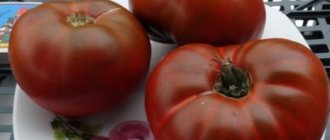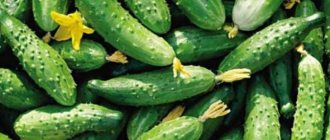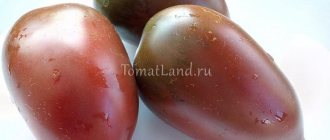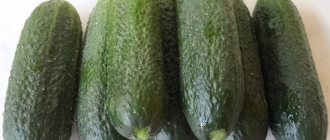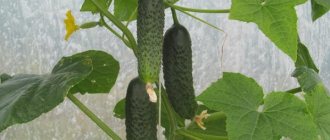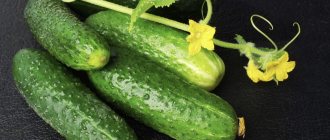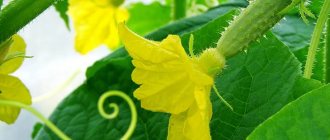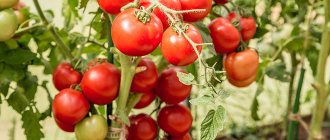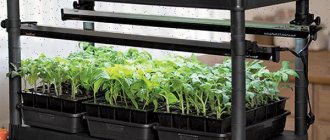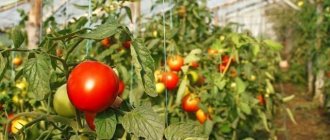Emerald scattering F1 is a new product in the line of hybrids. Ripe cucumbers have an attractive appearance, wonderful taste and excellent possibilities for pickling and preservation.
| Landing location | Ripening time | Mode of application | Fruit length | Group | Fruit smoothness | Pollination method |
| Universal | Early ripening (35-45 days) | Universal | Medium - from 10 to 15 cm | Hybrid | Highly lumpy | Parthenocarpic |
Yield hybrid Emerald placer F1 - description
This hybrid is parthenocarpic, and this alone determines the presence of many positive characteristics in the Emerald Placer:
· powerful stem development;
· abundant fruiting;
· immunity to many “traditional” cucumber diseases.
This cucumber does not need insects for pollination; it grows and bears fruit well both in a greenhouse and in the open air.
ON A NOTE! When grown in greenhouses and under shelters, the yield of Emerald Placer is up to 24-25 kg per m2.
This is an early ripening cucumber hybrid; in a greenhouse, with appropriate agricultural technology, the first fruits can be harvested as early as 40-42 days (the seedlings were planted in mid-May, and the greens were harvested by mid-June). In the middle zone and to the south it can be grown on ridges without shelters; in the northwestern regions, in the Urals and to the east, cultivation in greenhouses is recommended.
The plant is powerful and vigorous, but the branching is weak. In a hybrid, the side shoots have a limited length, and this allows you to avoid dense plantings even without forming a bush. The leaves are medium sized, bright green in color. Each node usually produces two or three ovaries.
The fruits of the Emerald Placer are beautiful - dark green, white-thorned, with large tubercles. The average length of Zelentsy is 10 cm; there are specimens of greater length – up to 12 cm.
Cucumbers hanging on the bush are pleasing to the eye, the plant looks very picturesque (see photo). The taste of cucumbers is pleasant, aromatic, the pulp is very dense, there are few seeds.
Hybrid cucumbers are ideal for canning (they can be picked at the gherkin stage) and, of course, are delicious fresh.
The hybrid has proven itself well in various areas; those summer residents who have grown it at least once do not refuse the Emerald Placer in the future.
Characteristics of the variety
- By planting the Emerald Placer hybrid, the vegetable grower can count on getting an early harvest. From the moment of the appearance of full shoots to the start of fruiting, only 38 to 42 days pass;
- The fruiting period of a cucumber is quite long, while the gardener picks greens in the lower nodes, flowering and the formation of new ovaries continue in the upper leaf axils. Hence the high yield of the variety. According to the State Register, under film covers you can collect 12.8 kg from 1 square meter;
- Our hero’s belonging to hybrids already means his high immunity and resistance to major pumpkin diseases. Our hero perfectly resists powdery mildew and downy mildew, as well as cladosporiosis (or brown olive spot);
- The main trump card of the Emerald Placer is its belonging to parthenocarpics. This amazing ability of a plant to set fruit without the help of pollinating insects is the main criterion not only when choosing varieties for the greenhouse. In open ground under unfavorable weather conditions, bee-pollinated varieties may not produce a crop, since insects do not pollinate plants in bad weather;
- You will have to harvest cucumbers often, every day or two;
- the variety tolerates a lack of light very well, and where conventional varieties can reduce productivity due to this factor, Emerald Placer bears fruit well. Thanks to this feature, combined with parthenocarpy, the crop can be grown at home - on a balcony or loggia;
- the uniformity and bright color of the fruits gives them a high presentation;
- transportability is beyond praise. The crop tolerates long-term transportation well. Keeping quality, subject to storage rules, is excellent; cucumbers do not turn yellow during storage;
- The method of consuming the crop is universal. Cucumbers go well with other early vegetables in vitamin salads; you can also enjoy them in their natural form, because the crispy, aromatic pulp has a pretty good taste. The fruits are also used for pickling and canning.
Advantages and disadvantages of the “Emerald Placer”
The main advantages of the “Emerald Placer”:
· Strong immunity;
· Abundant fruiting;
· Ability to grow in any conditions;
· Excellent marketability and taste of fruits;
· Parthenogenesis.
The disadvantages of a hybrid are related to its dimensions:
· For growing in closed conditions you will need a high greenhouse;
· When cultivated in open ground, the plant is strongly influenced by wind loads;
· Complex agricultural technology.
Planting and caring for cucumbers Emerald Placer F1
The variety is recommended to be grown in seedlings. It is best to calculate the time for sowing seeds for seedlings yourself, always taking into account the climate.
Three- or four-week-old seedlings can be transplanted indoors in mid- or late May. Emerald Placer seedlings can be planted in open ground 2 - 3 weeks later.
In order for the plant to develop well, it needs warmth, so try to allocate well-lit areas for the beds. But in the south, when growing outdoors, it is still better to plant cucumbers in a place where light partial shade protects from the hot sun during the midday period.
Planting pattern: 30 - 40 cm between bushes, 70 cm width between rows. After transplanting, each plant must be tied to a trellis. The variety loves watering. But it is worth remembering that to moisturize you need to use only warm water. As fertilizing, universal balanced fertilizers containing microelements necessary for growth and fruiting are used. When growing in a greenhouse, humidity levels should be controlled. To do this, use ventilation, but only on the leeward side, and loosening the soil after the next watering.
Many vegetable growers are just beginning to get acquainted with the Emerald Placer. But those who have already grown the hybrid have an excellent opinion about it.
The yield will not fail either in open ground or in closed ground. Immunity is high, so the number of chemical treatments can be minimized. In addition, the variety can be safely grown on the balcony, although at home you will have to control the growth of the main stem.
Some vegetable growers who cultivate cucumbers for sale have already tried the hybrid in commercial cultivation and were also pleased with the results. There are no obvious disadvantages of the variety. The only inconvenience is the inability to collect seeds yourself. Therefore, you will have to purchase seed material regularly.
Tips for the garden, vegetable garden and flower garden
Caring for raspberries in the spring at the dacha in an open area
Tree peony care and cultivation in the Moscow region
How to prepare yeast as fertilizer for seedlings
Agricultural technology and proper cultivation: sowing seeds for seedlings, picking
It is recommended to grow “Emerald Placer” using seedlings. It should be taken into account that the seeds of the first generation hybrids are not intended for cultivation in the second and subsequent generations, therefore they are purchased anew before each sowing.
Purchased seeds are disinfected with potassium permanganate, treated with growth stimulants (Epin, Zircon), then sowed. It is advisable to sow immediately into individual containers - this will avoid unnecessary stress during picking. Two seeds are placed in one pot so that a week after germination, selection can be carried out, leaving one of the strongest sprouts.
Seedlings are grown in a warm, well-lit room (air temperature - 22-24 * C, daylight hours - 14-16 hours). After the second true leaf unfolds, the seedlings are fed with complex fertilizer “Stimul-1” or a solution of mullein is prepared. It is also necessary to ensure that the substrate for seedlings is constantly moist.
Plants are transplanted to a permanent location in late May - early June. At this point, the stem of the cucumbers stretches up to 30 cm, and each plant acquires 5-6 leaves.
Reviews about the variety from those who planted
Valery: I don’t have any problems with growing. If you plant them correctly from the beginning in well-fertilized soil, when warm weather has already settled, then the bushes will grow further on their own; all that remains is to water them. I rarely prune; they have a strong main stem that tends upward, and the lateral ones are weak and sparse.
The harvest is huge, I plant 2 bushes per square meter and collect 10 kilos, or even 12, from each. All cucumbers are bright green, with beautiful pimples and thin skin, almost no seeds. It’s nice to eat them either fresh or canned, they are crispy, without voids, sweetish and juicy.
Marina: It self-pollinates, so I only grow it in a greenhouse, it’s more reliable and the yield is greater. I consider the variety to be unpretentious, it is strong, does not get sick, and seedlings are always accepted. 1.5 months after transplanting into the ground, I remove the greens. Loves warmth. I live in the south, but I don’t risk planting it in April, we have recurring frosts, and for it it’s death.
I plant in warm soil after the May holidays, the harvest appears on the 10th of June. I make sure that the fruits do not grow more than 10 cm; I partially remove them when they grow to 7 cm in order to tighten the gherkins for the winter. Placer has no noticeable shortcomings; I have been growing this particular variety for many years now.
Anna: The variety is young, so purchasing seed material is sometimes difficult. Seeds obtained independently are not suitable for propagation. The bushes have moderate climbing and an average number of leaves, but their growth potential is unlimited. Plants easily grow up to 2 meters in height.
Horizontal cultivation is not possible, only on trellises. Pollinating insects are not required for the formation of ovaries; there are no difficulties with cultivation under cover. The taste is excellent. The pulp is very juicy, with a sweetish aftertaste. Bitterness is absent genetically.
0
Briefly about the plant and its fruits
The characteristics and description of the Emerald Family F1 variety are as follows:
- The hybrid belongs to the group of plants with early ripening periods. From the appearance of the first shoots to the receipt of a full harvest, about 45 days pass.
- The height of the bushes can be more than 1.0-1.2 m. Cucumbers of the described variety have a female type of flowering.
- The fruits are cylindrical in shape, and the surface of the cucumber is covered with a large number of green tubercles and white spines. Inside the pulp contains a large amount of juice.
- The fruits have a diameter of 35 to 40 mm and a length of 100 to 120 mm. Their weight ranges from 0.12-0.13 kg, but reviews from gardeners show that if you follow all the breeders’ recommendations, you can get fruits weighing up to 150 g.
The yield of the variety is 14.5-15.5 kg of fruits per m² of bed. Farmers note that the Emerald Family is immune to such common vegetable diseases as cladosporiosis, various forms of powdery mildew, and cucumber mosaic virus.
The hybrid is grown in open ground in the southern regions of Russia. In the middle zone, greenhouses without heating are used for growing vegetables. For the northern regions of Russia, it is typical to grow the hybrid in greenhouses and greenhouse complexes with heating.
To get a good harvest in open areas, cucumbers must be sown in prepared soil. To do this, loosen the soil and add the necessary fertilizers. If necessary, the soil is disinfected with a solution of potassium permanganate.
See also
Description of Parker f1 cucumbers, three ways to grow a hybrid variety Read
The crop should be sown in well-lit areas that are protected from the wind. You cannot sow cucumbers on soils where related crops or squashes, zucchini and pumpkins previously grew. The soil in the beds is enriched with humus. It is better to sow the hybrid in loamy or sandy soil. For better growth of bushes, organic fertilizers are used.
